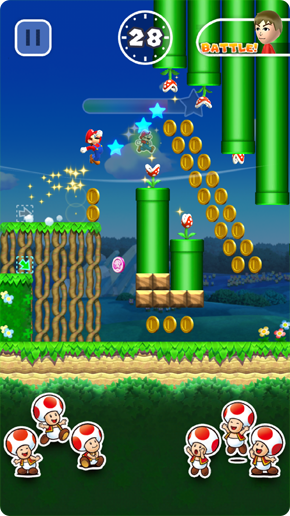Our extra-large special edition is here. Subscribe today and receive the 25% longer issue at no extra cost!
Super Mario Run

The biggest star in console gaming history making his debut on phones
is undoubtedly a big deal, but don’t expect a transformative (or even
noteworthy) experience from Mario’s first iPhone adventure. During my
lunch break today, I traveled to the Mall of America to check out the
Super Mario Run demo that is currently only available in Apple Stores.
An
Apple employee told me that the demo is playing on practically every
tablet and phone in the store, so you shouldn’t have any troubles
getting your hands on it if you want to check it out for yourself. I
decided to play it on the new iPhone 7 Plus, which may have sold me more
on the hardware than the game.
Right off the bat, it’s strange
to see Mario’s face on an iPhone app. The times are certainly changing,
and we’ll soon see Animal Crossing and Fire Emblem here as well.
The
game booted up within a matter of seconds, and offers three avenues of
play: World Tour, which is a campaign comprised of six worlds, each
offering four levels, Toad Rally, a high-score competition presumably
through the same stages, and Kingdom Builder, where you can exchange
coins build houses and other bonuses.

The only option available to me is World Tour. Unlike most Mario
games which offer a map to explore, all Super Mario Run’s campaign
levels fit onto one screen, showing Level 1-1 through 6-4. You can tap
each stage to quickly jump in. From the outset of play,
however, only stage 1-1 is available. This level is called Up and Over,
the “up” presumably referring to gaining high ground for bonuses, and
the “over” I can only assume refers to just how short the stage is.
Holding
true to what Nintendo has said all along, Super Mario Run can be played
comfortably with one hand, and that functionality works remarkably
well. After tapping the screen to initiate Mario in a full-blown sprint,
he runs along on his own. I simply had to tap the screen to guide him
along, whether that was leaping over chasms, timing a jump to land on a
goomba or koopa, or hold the button down to gain an extra boost of air
to reach a higher platform, where a mushroom or extra coins awaited.
As
simple as this sounds, there is a surprising complexity to it. Nintendo
did a nice job of diversifying the challenges, making you tap the
screen in different rhythms all the way through the level. Mario also
runs into pads on the ground with different symbols on them. If you see
an arrow pointing forward or diagonally up, something may happen when
you tap the screen when Mario crosses over it. On this stage, tapping
the diagonal arrow created a row of coins for him to grab. In other
stages, arrows pointing to the left would generated a speed boost, which brought with it a higher level of difficulty. A pause sign will make
Mario stop in his tracks, something I saw when moving platforms come
into play, so the player can time their approach.
Again, I didn’t
feel like I was playing this first stage for long, and managed to get
through it in what felt like just over a minute. The final moments of
the level unfold as you would expect, with Mario ascending a staircase
and trying to jump to the top of a flagpole to gain bonus points. As I
played, I had the chance to grab purple bonus coins, of which there are a
finite number in each stage. I missed two of them, but did see how to
get them (they weren’t hidden too far off the beaten path). The most
interesting post-level reveal is a screen that said I killed 6 of 200
Goombas. This is a high number, and I thought it was keeping a tally of
my entire time with the game, but it seemed to keep track of the kills
on level-by-level basis, meaning I need to kill 200 in 1-1. There’s also
the chance the demo isn’t tracking this data accurately yet.
The second stage, Wall-Kicking It Underground, is the same level Jimmy Fallon played on the Tonight Show. This level acts as a bit of a tutorial in teaching the player how to bounce back and forth on walls to reach higher ground. If Mario leaps back to the left onto a ledge, he will immediately turn around and start running again. He’s all about forward progress in this game, and Nintendo clearly had fun designing challenges around this design. A good bit of fun comes from reacting quickly and in a split second determining if you are going to use a standard or charged jump.
 This
stage again felt like it flew by in a minute, and I found myself
booting up the demo’s third, and most challenging stage, Paratroopas in
Mushroom Valley. This stage is filled with pitfalls and tough
platforming sequences that again require precise timing. One thing I
noticed: it’s hard to take on damage in this game. Yes, you get
mushrooms to make you grow and let you withstand a hit without dying, but I often felt like
a bad jump onto an enemy’s head was given to me. I also thought I
didn’t hit jump quickly enough, but Mario somehow vaulted over the
enemy. I had one instance where I missed a jump over a chasm completely,
but Mario bounced off of the back wall and I was given a second chance
to get over it. This stage was good fun, but again, incredibly short.
This
stage again felt like it flew by in a minute, and I found myself
booting up the demo’s third, and most challenging stage, Paratroopas in
Mushroom Valley. This stage is filled with pitfalls and tough
platforming sequences that again require precise timing. One thing I
noticed: it’s hard to take on damage in this game. Yes, you get
mushrooms to make you grow and let you withstand a hit without dying, but I often felt like
a bad jump onto an enemy’s head was given to me. I also thought I
didn’t hit jump quickly enough, but Mario somehow vaulted over the
enemy. I had one instance where I missed a jump over a chasm completely,
but Mario bounced off of the back wall and I was given a second chance
to get over it. This stage was good fun, but again, incredibly short.
The final stage of World 1 is Bowser’s Castle Hangout. The demo
allows players to try it, but for only 20 seconds (which I originally
thought was far too short, but now realize may have been roughly half of
the level). Fireballs, lava pits, and everything you’ve come to expect
from these stages in older Mario games are here. The brief part I played
again felt a little tougher than the previous stages, but nothing
brought my death. In fact, I didn’t die once during my first time
through the demo, and went back to see if I could in fact perish. In
stage 1-1 I purposely messed up a jump and Mario died in a pit. Messing
up an interaction with an enemy is a little more challenging. As I said,
it seems way too forgiving in this capacity, especially when stacked up
against other Mario games, but I did eventually run into a koopa that
knocked Mario off of the stage.
Super Mario Run didn’t blow my
socks off, and instead felt like a fairly pedestrian Mario experience –
the big difference is I can play it on my phone with one hand. It has a
nice speedrun quality to it, but I fear an hour is all you’ll need to
make it through all of World Tour, if in fact there are only six worlds.
We’ll have to wait until the official release next Thursday to see what
the other modes hold, but from what I played, Mario is not a disruptive
force in the auto-runner genre, but at least bucks the trend of endless
level designs to give players a break and more variety to dive into.
There's clearly a strong push for replaying levels in this game, and,
well, I just don't know how compelling that aspect will be until I get
my hands on the finished product. The verdict is coming soon; we’ll have
a full review of Super Mario Run next week when it launches in Apple’s
App Store.

Get the Game Informer Print Edition!
Explore your favorite games in premium print format, delivered to your door.
- 10 issues per year
- Only $4.80 per issue
- Full digital magazine archive access
- Since 1991









